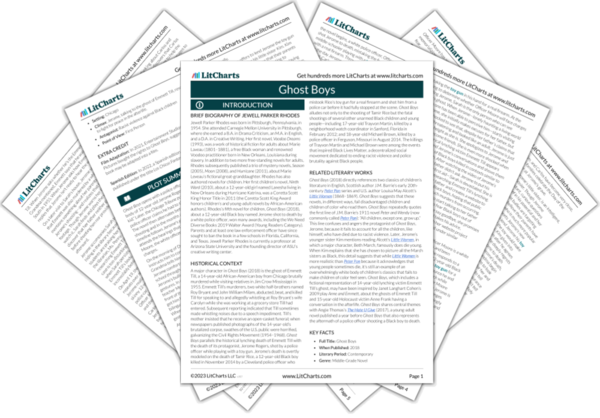Ghost Boys follows the ghost of a 12-year-old Black boy, Jerome Rogers, in the months after a white police officer shoots Jerome while he’s playing outside with a toy gun. By also telling the story of historical figure Emmett Till, a Black boy who was murdered by a lynch mob in 1955, the novel shows how the U.S. has made progress toward racial equality since Emmett Till’s experience in the “Jim Crow” South—but not nearly enough progress. That is, while it is less common for white people in the U.S. to be consciously, unrepentantly, proudly racist now, the novel makes it clear that subconscious racism can and still does kill Black people. The only way to make more progress, Ghost Boys suggests, is to “bear witness” to Black victims of racist violence, sharing their stories so that everyone becomes consciously anti-racist.
Ghost Boys makes this point through the parallel stories of its protagonist, a 12-year-old Black boy named Jerome Rogers, and the real historical figure Emmett Till. Emmett, who was murdered because he supposedly whistled at a white woman, mentions that his killers never repented of murdering him and were never charged with murder. Jerome, haunting Officer Moore’s house, sees the man miserable and frequently drinking despite having avoided murder charges—and wonders whether Officer Moore’s guilt counts as “progress.” Ultimately, Jerome encourages Officer Moore’s daughter Sarah—a middle-schooler, horrified by her father’s actions, who is only living person able to see Jerome—to keep the story of his unjust killing alive so that more substantive progress can be made to end racist murders of Black children in the U.S. At the novel’s end, Jerome also speaks directly to readers, ordering them to “bear witness” to prevent more murders. This ending emphasizes that Ghost Boys exists to uproot subconscious racism and encourage anti-racism through storytelling.
Progress, Storytelling, and Justice ThemeTracker

Progress, Storytelling, and Justice Quotes in Ghost Boys
I’m pudgy, easily teased. But when I’m a grown-up, everybody’s going to be my friend. I might even be president. Like Obama.

Unlock explanations and citation info for this and every other Ghost Boys quote.
Plus so much more...
Get LitCharts A+Grandma dropped out of elementary school to care for her younger sisters. Ma and Pop finished high school. Me and Kim are supposed to go to college.
“Every goodbye ain’t gone,” Grandma says.
“Emmett. Just like Emmett Till,” says Grandma. “He was a Chicago boy, too.”
“This isn’t 1955,” says Reverend, calming.
“Tamir Rice, then,” shouts Pop. “2014. He died in Cleveland. Another boy shot just because he’s black.”
“You’re nothing in Chicago. Say it.” Snap twists Carlos’s arm. “Say it, ‘I’m nothing.’”
“Black lives matter!” someone hollers.
“We could be friends.”
“That’s the stupidest thing.” I’ve never had a friend like Sarah. A white girl. I laugh, it’s so stupid. Die, and a white girl can be your friend.
“I’m not trying to be funny. Stay.”
She’s pleading. I feel sorry for her. My school doesn’t have any Sarahs.
Who knew THE END wasn’t the end?
“What’re you going to be, Sarah?” I shout. “You’re the only one who’s going to grow up.”
“You’re the Chicago boy? Murdered like me?”
“1955. Down South.”
Everybody knew the South was dangerous then.”
“Still is,” answers Emmett.
Emmett’s the leader. The leader of our crew. An unnatural alliance—young, but dead.
Ghost boys.
I understand now. Everything isn’t all about me.
Emmett murmurs, “Bear witness.”
“What’s that mean?”
“Everyone needs their story heard. Felt. We honor each other. Connect across time.”
“Can’t undo wrong. Can only do our best to make things right.”
Emmett told me that the men who killed him never believed they did wrong. An all-white jury found them innocent.
The judge said there wasn’t enough evidence to charge Officer Moore with a crime. But he’s not celebrating.
Is that progress?
Bear witness. My tale is told.
Wake. Only the living can make the world better.
Live and make it better.











